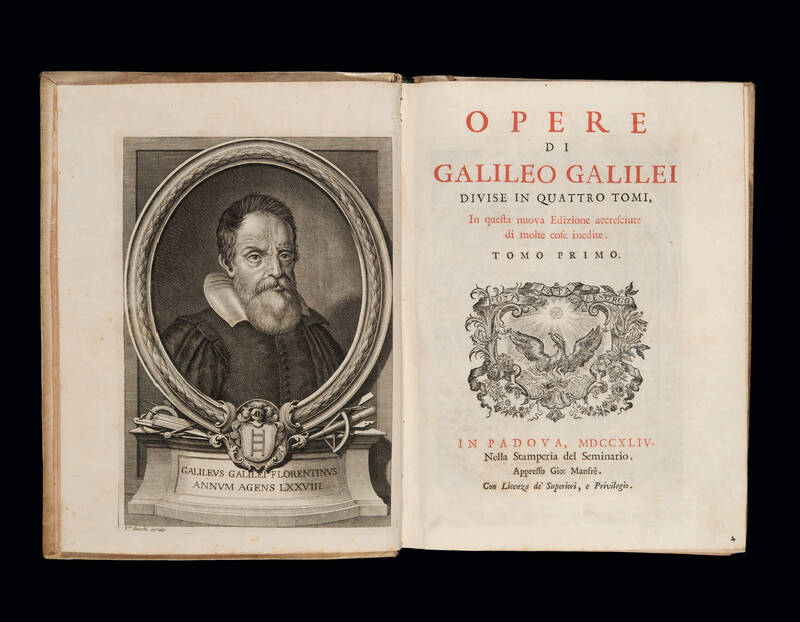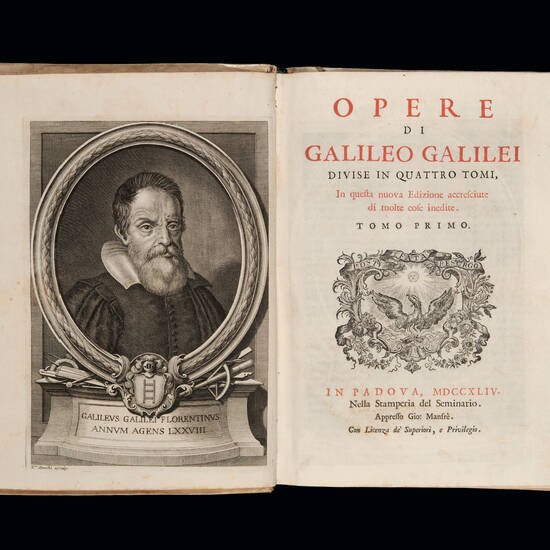GALILEI, Galileo.. Opere, divise in quattro tomi, in questa nuova edizione accresciute de molti cose inedite.
Padova: Manfre, 1744, Manfre., 1744Four volumes, quarto (245 x 178 mm.), I: portrait of Galileo, [8], 602 pages and a folding table; II: [4], 564 pages; III: [4], 486 pages; IV: [8], 343 pages with numerous diagrams and illustrations in the text. Very minor marginal foxing, overall a very good set in contemporary stiff vellum, gilt title om spines.
Rare third edition of Galileo's complete collected works in four volumes, the first edition to include the controversial text of Dialogo sopra i due massimi sistemi del mondo. Published on the centenary of Galileo's death, this edition's title page is printed in red and black, with a portrait frontispiece of Galileo surrounded by mathematic and astronomic instruments engraved by Francesco Zucchi (1692 - 1764). Richly illustrated throughout, the first volume contains a fold-out plate, as well as numerous in-text diagrams. The work was edited and includes commentary by Giuseppe Toaldo (1719 – 1797), Catholic priest and professor of astronomy at the University of Padua.
Galileo Galilei (1564 – 1642) “initiated modern observational astronomy, which studies the universe as a physical structure; and he announced himself as a Copernican. By so doing and by asserting, with the evidence of his instrument (the telescope), that the universe was very unlike what Aristotle and the ancients had described, Galileo revived the smouldering Copernican dispute.” (PMM 113) His seminal works and crucial observations of the skies and tides are present in this four-volume compilation, among them Sidereus Nuncius, Il Saggiatore, and Istoria e dimostrazioni intorno alle macchie solari. As a champion of heliocentrism, he was investigated by the Roman Inquisition in 1615, and in 1616 the Inquisitorial commission declared heliocentrism to be "foolish and absurd in philosophy, and formally heretical since it explicitly contradicts in many places the sense of Holy Scripture". Galileo was ordered to abandon heliocentric theories and not to defend or teach such heretical ideas.
The much controversial work here included for the first time, the Dialogo, “is not, nor was it intended to be, a dry treatise in astronomy and natural philosophy. It is rather a polemical writing and, at the same time, didactic in support of Copernicanism. In writing it, Galileo remembered quite distinctly the long years of battles with the Aristotelians, their unshakable opposition to new ideas and to new discoveries.” (Fantoli, p.321) The Dialogue itself is conducted by three people: an open advocate of the Copernican doctrine, an obtuse and obstinate follower of Aristotle and Ptolemy, and an impartial participator open to conviction. Despite the initial approval in 1632 by the Viceregent of Rome, the Master of the Sacred Palace, the Vicar General of Florence, the Florentine Inquisitor and the government of the Grand Duke, within months of publication, the work was placed on the Index of Forbidden Books under suspicion of heresy, and there it remained until 1835. Uniquely, the Dialogue received the prescribed ecclesiastical permission to be printed in the present edition, that of 1744 - 91 years before it was removed from the Index. However, this was under the condition of stating in the introduction that “the theory of the double motion must be regarded only as a mathematical hypothesis, to facilitate the explanation of certain natural phenomena. Besides this, the Dialogues had to be preceded by the sentence on and recantation of Galileo.” (Gebler p.313)
A previously unpublished treatise on sight measuring methods, Trattato del modo di misurare con la vista, as well as some of Galileo's correspondence, Ventitrè lettere a diversi, delle quali sedici al Micanzio e tre al Gualdo, were also first published in this edition of his works.
Despite Galileo's incarceration, in 1635 the Dialogues were sent to Paris in order to be translated into Latin and later English, eventually being published in Holland and widely circulated outside the range of the Index. By the time this third edition of Galileo's complete works was published, “it had long been perceived at Rome that, in spite of every effort, it was vain to try to bury the Copernican system with Galileo in the grave” (Gebler p.311)
Brunet II, 1461; Graesse III, 15; Gamba 484; Houzeau-Lancaster 3386; Carli-Favaro 478; Riccardi I, 522; Fantoli, Annibale. Galileo: For Copernicanism and for the Church, 1994; Gebler, Karl von. Galileo Galilei and the Roman Curia, 1879; Carter, John. Printing and the Mind of Man, 1967.

